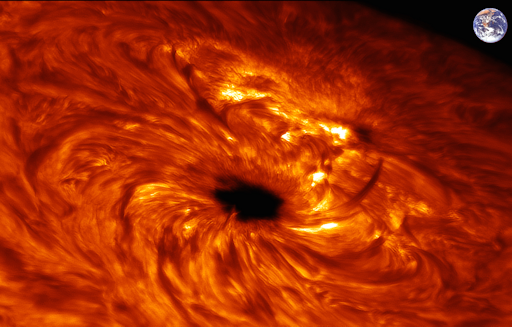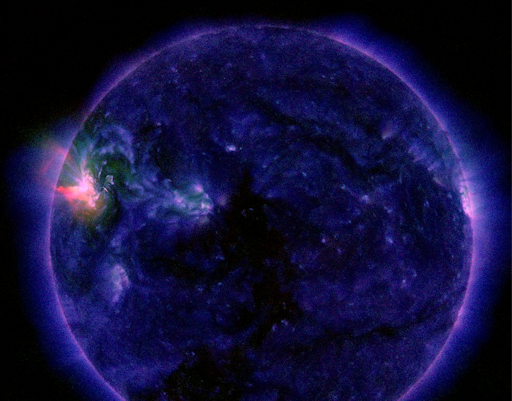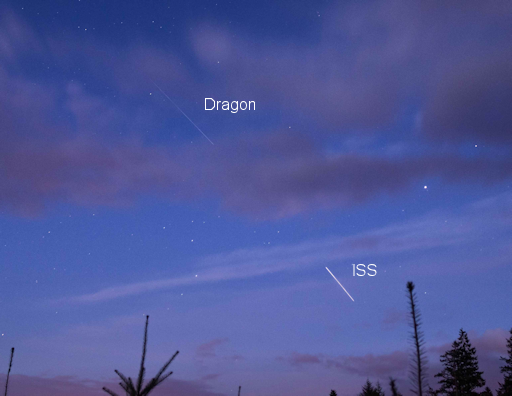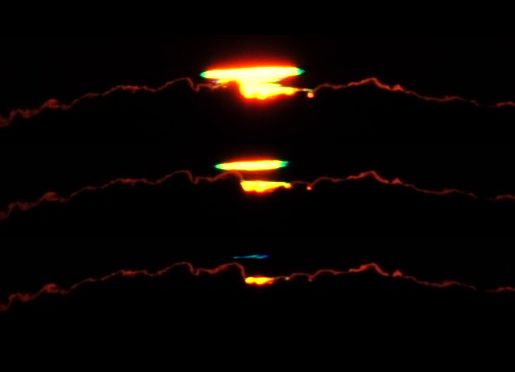Marianne's Heaven On Earth Aurora Chaser Tours Chasethelighttours.co.uk invites you to join them in their quest to find and photograph the Aurora Borealis. Experience the winter wonderland in the Tromsø Area. | | |
SPACE WEATHER ON FACEBOOK: Are you on Facebook? Good news: So is Spaceweather.com! If you would like to see our daily content in your Facebook feed, just click here and follow us.
BIG SUNSPOT GETS BIGGER: Sunspot AR2529 has more than doubled in size this weekend, making it by far the largest sunspot of 2016 to date. Around the world amateur astronomers are photographing the behemoth. Jean-Pierre Brahic of Uzès, France, took this picture on April 9th of the swirling maelstrom of magnetic fields at the sunspot's dark core:

As the inset image of Earth shows, the sunspot's core is wide enough to swallow our planet--twice. Fortunately we are 93 million miles away.
NASA's Solar Dynamics Observatory (SDO) is keeping a close eye on this active region. Magnetic fields near the sunspot's core are crackling with minor C-class solar flares. None of these flares are very strong, but the ensemble of explosions is doing a good job heating the sun's atmosphere above the sunspot. The towering "hot spot" is shown in this extreme ultraviolet image taken by SDO on April 10th:

Despite its large size and state of unrest, AR2529 has not yet launched a significant solar storm. C-class flares are considered to be small. Stronger flares may be in the offing, however, if the sunspot continues to grow in the days ahead. Stay tuned. Solar flare alerts: text or voice
Realtime Space Weather Photo Gallery
DRAGON SPACECRAFT CHASES, CATCHES THE ISS: Launched just two days ago, SpaceX's Dragon CRS-8 spacecraft has spent the weekend chasing the International Space Station around Earth. Last night, April 9th, in Normandy, France, photographer Guillaume Doyen witnessed the pursuit:

"The ISS had just passed overhead when I saw the small and sharp point following it," he says. "Hello Dragon, what a surprise!"
The Dragon CRS-8 is carrying almost 7,000 pounds of cargo to the space station--including a new inflatable addition to the station's sprawling structure. The Bigelow Expandable Activity Module--BEAM for short--will arrive in Dragon's unpressurized trunk and, after about five days, will be removed and attached to the station. Expansion is targeted for the end of May. The module will expand to roughly 10 feet in diameter and 13 feet long.
Expandable habitats are designed to take up less room on a rocket, but provide greater volume for living and working in space once expanded. This first in situ test of the module will allow investigators to gauge how well the habitat protects against solar radiation, space debris and contamination.
Not long after Doyen saw them in the skies over France, the Dragon and the ISS docked on Sunday, April 10th. Visit NASA.gov for more information.
EXOTIC GREEN FLASH: Seaside photographers have a special fondness for the sunset. On rare occasions they can catch the elusive green flash--a split-second pulse of verdant light that signals the disappearance of the sun beneath the ocean waves. On April 7th, astronomy professor Jimmy Westlake photographed a green flash as he stood atop Hawaii's Mauna Kea volcano. The flash he saw, however, did not come from the ocean waves. It happened in the clouds:

"The SKY Club from Colorado Mountain College got an emerald surprise," he says. "Several students visually witnessed the green flash while I was photographing it."
"This appears to be a cloud-top flash," says atmospheric optics expert Les Cowley. "They are not fully understood but might be produced by an inversion layer overlaying the clouds."
Basically, a temperature inversion bends the sun's rays to form a mirage that vertically magnifies the tiny color separation which is always present at the edge of the setting sun. In Westlake's flash, we see not only green, but also yellow, red, and even a wisp of blue. "The intensity of the blue-green flash caught everyone by surprise!" says Westlake.
Realtime Aurora Photo Gallery
Solar Eclipse Photo Gallery
Realtime Comet Photo Gallery
[More about Comet 252P: brightness measurements, 3D orbit, orbital elements]
Every night, a network of
NASA all-sky cameras scans the skies above the United States for meteoritic fireballs. Automated software maintained by NASA's Meteoroid Environment Office calculates their orbits, velocity, penetration depth in Earth's atmosphere and many other characteristics. Daily results are presented here on Spaceweather.com.
On Apr. 10, 2016, the network reported 7 fireballs.
(7 sporadics)

In this diagram of the inner solar system, all of the fireball orbits intersect at a single point--Earth. The orbits are color-coded by velocity, from slow (red) to fast (blue). [Larger image] [movies]
Potentially Hazardous Asteroids (
PHAs) are space rocks larger than approximately 100m that can come closer to Earth than 0.05 AU. None of the known PHAs is on a collision course with our planet, although astronomers are finding
new ones all the time.
On April 10, 2016 there were potentially hazardous asteroids.
Notes: LD means "Lunar Distance." 1 LD = 384,401 km, the distance between Earth and the Moon. 1 LD also equals 0.00256 AU. MAG is the visual magnitude of the asteroid on the date of closest approach. | | Cosmic Rays in the Atmosphere |
| Situation Report -- Oct. 30, 2015 | Stratospheric Radiation (+37o N) |
| Cosmic ray levels are elevated (+6.1% above the Space Age median). The trend is flat. Cosmic ray levels have increased +0% in the past month. |
| Sept. 06: 4.14 uSv/hr (414 uRad/hr) |
| Sept. 12: 4.09 uSv/hr (409 uRad/hr) |
| Sept. 23: 4.12 uSv/hr (412 uRad/hr) |
| Sept. 25: 4.16 uSv/hr (416 uRad/hr) |
| Sept. 27: 4.13 uSv/hr (413 uRad/hr) |
| Oct. 11: 4.02 uSv/hr (402 uRad/hr) |
| Oct. 22: 4.11 uSv/hr (411 uRad/hr) |
These measurements are based on regular space weather balloon flights: learn more. Approximately once a week, Spaceweather.com and the students of Earth to Sky Calculus fly "space weather balloons" to the stratosphere over California. These balloons are equipped with radiation sensors that detect cosmic rays, a surprisingly "down to Earth" form of space weather. Cosmic rays can seed clouds, trigger lightning, and penetrate commercial airplanes. Our measurements show that someone flying back and forth across the continental USA, just once, can absorb as much ionizing radiation as 2 to 5 dental X-rays. For example, here is the data from a flight on Oct. 22, 2015:

Radiation levels peak at the entrance to the stratosphere in a broad region called the "Pfotzer Maximum." This peak is named after physicist George Pfotzer who discovered it using balloons and Geiger tubes in the 1930s. Radiation levels there are more than 80x sea level.
Note that the bottom of the Pfotzer Maximim is near 55,000 ft. This means that some high-flying aircraft are not far from the zone of maximum radiation. Indeed, according to the Oct 22th measurements, a plane flying at 45,000 feet is exposed to 2.79 uSv/hr. At that rate, a passenger would absorb about one dental X-ray's worth of radiation in about 5 hours.
The radiation sensors onboard our helium balloons detect X-rays and gamma-rays in the energy range 10 keV to 20 MeV. These energies span the range of medical X-ray machines and airport security scanners.
| | The official U.S. government space weather bureau |
| | The first place to look for information about sundogs, pillars, rainbows and related phenomena. |
| | Researchers call it a "Hubble for the sun." SDO is the most advanced solar observatory ever. |
| | 3D views of the sun from NASA's Solar and Terrestrial Relations Observatory |
| | Realtime and archival images of the Sun from SOHO. |
| | from the NOAA Space Environment Center |
| | the underlying science of space weather |

